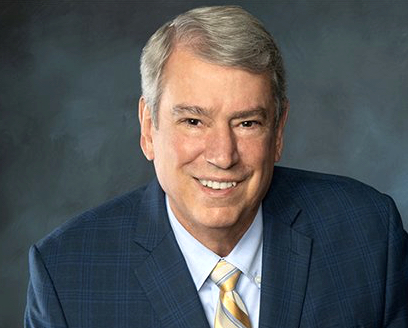Editor’s note: the following commentary has been made available through the Wisconsin Technology Council.
By Tom Still
At the Coachman’s Inn just north of Edgerton, Universities of Wisconsin President Jay Rothman stood in a private dining room to make his case for why public financial support for the UW system must rise beyond its current ranking of 43rd among the 50 states.
He even brought along a supply of circular “43! No more” stickers to illustrate the point.
The audience was largely comprised of members of the Edgerton Chamber of Commerce, but some local officials and others were among the three-dozen people who came to dine and hear Rothman explain why UW’s network of campuses needs another $855 million in state support over the next two years.
“It’s time Wisconsin escapes the bottom 10 in public funding and gets up to the middle,” Rothman said. “We won’t win the ‘war for talent’ if we don’t get up to the middle … We’re falling behind after years of neglect.”
There is data to support the notion of eroded public support. Wisconsin ranks 43rd of 50 states in public funding of four-year higher education, according to the latest State Higher Education Finance report by the State Higher Education Executive Officers Association. The figure includes state funding and tuition. Surrounding states rank first (Illinois), third (Michigan), ninth (Iowa) and 10th (Minnesota), respectively.
Even with Gov. Tony Evers’ intent to include at least $800 million in new UW funding in his 2025-27 budget bill, the effort to climb the 50-state ladder remains a tough exercise. That’s why Rothman, who exudes a mix of Marathon County farm boy charm and big-business chops, is taking the message to people who might be able to help.
Rothman and the Board of Regents must overcome skepticism in the state Capitol, where a recent analysis by the Legislative Fiscal Bureau showed the Universities of Wisconsin employed about 6,000 more people in the 2022-23 academic year than it did in 1992-93. During the same period, overall enrollment climbed only slightly, from about 160,000 in 1992-93 to 163,589 expected this fall.
“Only in government would you witness a 6,000-person staffing increase in an organization with no new customers,” said Rep. David Steffen, R-Howard, who requested the fiscal bureau analysis. “If the UW system wants the Legislature and taxpayers to take their massive … budget increase seriously, they’ll need to provide much more than flowery talking points.”
For now, talking points are part of the public-relations strategy behind the UW’s push, in hopes that business owners and civic leaders who are generally hungry for talent will push to expand the number of four-year graduates. Some worry Wisconsin will lose home-grown students to surrounding states that may be better able to help cover education costs.
The explanation for the 6,000 extra employees spread over 30 years has several parts. First, roughly three-quarters of those jobs were clustered at the UW-Madison, which grew its enrollment substantially and matured as a top-line research university. What was once a $359 million research enterprise is now $1.5 billion, with implications for the larger economy.
The UW also took over the UW Extension and Wisconsin Public Media, which were previously separate. Since 2018, a UW spokesman has noted, the number of employees outside Madison has declined by about 1,000 people. Also, students increasingly smaller classes when possible, so the faculty-student ratio has shifted on some campuses. The need for more students in science, technology, engineering and math is another factor.
Meanwhile, there is belt-tightening around the UW in the form of two-year campus closings, attrition in jobs and even some layoffs.
All important factors, but some lawmakers may counter that while public support for four-year colleges is low, tax support for the Wisconsin Technical College System is robust. In 2021, Wisconsin’s technical colleges received $17,153 per full-time equivalent student in state and local tax and tuition funding, good for fifth among the 50 states. Local property taxes help to support technical colleges.
In his Edgerton remarks, Rothman described the enduring value of a four-year degree – not only for students, but for those who want to hire adaptable, well-rounded people. This may be a hard debate to win, one chamber of commerce or Rotary Club at a time, but Rothman is giving it the “old college try.”
Still is president of the Wisconsin Technology Council. He can be reached at tstill@wisconsintechnologycouncil.com. His opinion pieces are found on the Wisconsin Technology Council website: https://wisconsintechnologycouncil.com/newsroom/featured-news/.
